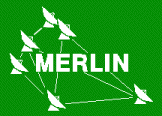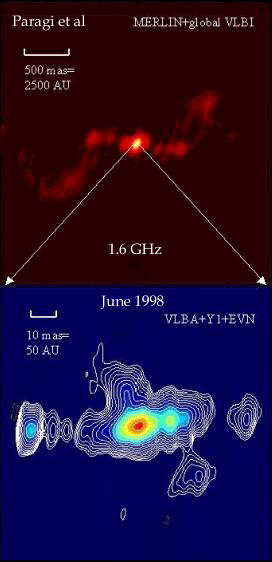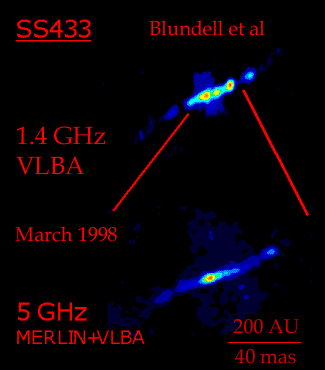
Newsletter

 |
Newsletter |
 |
| Number 3: November 2000 | ||||
| MERLIN | VLBI AT JBO | PROPOSALS | ARCHIVE | CONTACT |
| Contents | |
Director's Report
Many of you will be aware that an International Panel of astronomers
was asked to review the operation and future development of
MERLIN. The panel consisted of Miller Goss (NRAO: chairman), Alain
Baudry (Obs. De Bordeaux), Richard Hills (Univ. Cambridge) and Karl
Menten (MPIfR). Their report has now been produced and the full text
can be found on the MERLIN web page at:
The executive summary is reproduced here:
The review was carried out on 25 - 27 September 2000. The Panel members were M. Goss (Chair), A. Baudry, R. Hills and K. Menten.
The Panel thinks that the National Facility (NF) plays a significant and unique role in current observational astronomy. The astronomical topics for which its high resolution is relevant cover a wide range, from cosmology to galactic stars.
The restructuring of the facility since 1997 has resulted in the desired savings and has had positive effects. The appointment of a Director (initially internal and later from the outside) has worked well. The increased usage of the NF by outsiders is encouraging.
The budget has, however, been eroded due to the lack of indexation in the past and is not really adequate to support the agreed programme. Medium-scale improvements to Facility are not possible within the current budget.
The e-MERLIN proposal will provide a unique facility for high resolution cm-wave astronomy for at least ten years if it is begun in the next few years. It will increase the sensitivity and frequency coverage, so that a wide range of new astronomical projects can be undertaken.
The NF continues to play a key role in the European VLBI Network. The interactions between the JIVE correlator design and implementation and the NF have been productive.
The synergy between the University of Manchester astronomers and the National Facility is an important asset. This combination of expertise will insure that the UK remains a centre of excellence in interferometry that will play a significant role in ALMA and SKA in the future.
There are several other major events that have occurred since the previous issue of this newsletter. You are all aware of the furore that followed the announcement in early June by Eric Priest, chair of PPARC's Astronomy Committee, of the status of the UK's plans to join ESO. At the time of writing we still do not know if the UK will be a member of ESO or what will be required in terms of a restructuring of the ground-based astronomy programme. However, whatever happens Astronomy Committee have made a strong statement that if the UK does join ESO the costs associated with the annual contribution should be sought from the existing spend on ground-based optical/IR/mm facilities not from MERLIN.
Based upon the ESO debate mentioned above, an article appeared in the Sunday Times suggesting that Jodrell Bank faced imminent closure. The public support for Jodrell Bank and MERLIN that ensued was gratifying; questions were asked in the House of Commons and House of Lords. As a result, the Science Minister Lord Sainsbury issued a press release quashing the rumours and reassuring the JBO staff. During this period, there was considerable press, radio and TV interest.
At the same time, the NF staff were preparing the first proposal for the funding of e-MERLIN, the fibre-based upgrade aimed at producing more than an order of magnitude increase in sensitivity. The request was directed at the so-called North West Science Review, a panel set up by the DTI under the chairmanship of Dr. Bruce Smith with a budget of £25M and aimed at addressing the urgent needs of science in the North West of England following the decision to locate the DIAMOND synchrotron radiation source in Oxfordshire rather than at Daresbury. A highly professional proposal was prepared and submitted in collaboration with UMIST. Unfortunately, we were not successful in this attempt. The vast majority of the funds awarded went to bio-science projects. However, the e-MERLIN proposal was highly-rated and has been passed along to another panel, the NW Science and Daresbury Development Group, which will be passing recommendations for funding to the Secretary of State for Trade and Industry before the end of the year.
The major proposal for full funding of e-MERLIN is almost complete and will be submitted to PPARC this month. The full science case and technical specification will shortly be made available on the MERLIN web-site. The science case is very impressive and broad-ranging and has been prepared in collaboration with many astronomers from around the UK and from abroad, I thank them for all of their efforts.
As well as the review of MERLIN, we participated in a review of the European VLBI Network (EVN) and its Joint Institute for VLBI in Europe (JIVE). This was conducted under the auspices of the European Science Foundation (ESF) and carried out by a panel consisting of Jens Fenstad (Univ. Oslo: chairman), Len Culhane (UCL), Calogero Natoli (INFN Frascati) and Paul Vanden Bout (NRAO). The review was, like the review of MERLIN, very successful. The panel concluded that the science was `rich in substance and impact', the user community was of `sufficient critical mass' and that the EVN had `professionalised a dedicated networking approach which capitalizes on the availability of the world's largest diameter telescopes'. A report of the review appeared in Nature (vol 407, p437). If anybody is interested in receiving a copy of the panel's glossy report, please contact me at pdiamond@jb.man.ac.uk.
Finally, we had a little meeting called the General Assembly of the International Astronomical Union here in Manchester. MERLIN and VLBI science were strongly represented in many of the symposia and joint discussions. Immediately prior to the IAU, JBO hosted a Square Kilometre Array technical workshop; since e-MERLIN may well be a prototype for the SKA it was entirely appropriate that the workshop be held here. During the IAU a ceremony was held to sign an MoU forming the International SKA Steering Committee (ISSC). The ISSC contains representatives of the consortia that have recently been formed from radio observatories around the world; they have the common aims of designing, building and eventually operating the SKA.
Recent Science: SS433
SS433 is the first and best known example of a relativistic jet in our
Galaxy. Analogous to the jets emitted from the centres of some
galaxies, which are powered by supermassive black holes, the jets in
SS433 are ejected at speeds of 26% of the velocity of light and are
powered by a compact object (neutron star or black hole) with a
regular star as a companion. The normal star loses mass to the
compact object; this material is accelerated to high speeds and is
ejected in the form of jets in opposite directions away from the
system.

|
Individual components within the jets move in straight lines, tracing a helical locus as the axis of the system precesses. As a result of the proximity of SS433 this nearby Galactic radio source has become the paradigm for relativistic jets in general and the precessing jet model in particular. The combined MERLIN+global VLBI observations of Paragi et al (2000, IAU205), shown at the left, demonstrate this process well. |
VLBA+VLA observations taken in 1995 (Paragi et al 1999, A&A, 348, 910) sugested the presence of radio components at anomalous position angles to the normal jet emission. Paragi et al speculated that they might be related to an equatorial outflow or accretion disk, an idea already postulated from the interpretation of X-ray spectra of the jets.
This anomalous emission has recently been confirmed in a dramatic fashion by two different groups. Drs Katherine Blundell (Oxford), Amy Mioduszewski (Sydney), Tom Muxlow (Jodrell Bank Observatory: MERLIN) and Michael Rupen (NRAO) made state-of-the-art images of this rapidly evolving system in March 1998. They have used three of the world’s major interferometers simultaneously to observe SS433 at 1.4 and 5 GHz: the VLBA was used to provide information on the very small-scale structure, while MERLIN and the VLA were used to provide wide-field information. A total of 43 telescopes took part in this observation. At the highest resolution, these images probe physical scales as small as a few AU.
 |
A few months afterwards, Zsolt Paragi, Istvan Fejes (both of FOMI, Hungary), Rene Vermeulen (NFRA), Richard Schilizzi (JIVE), Ralph Spencer (JBO) and Alastair Stirling (UCLAN) performed similar observations with MERLIN, the EVN, the VLBA and one antenna of the VLA at 1.4 GHz. The montage of superb images from both groups is shown to the left. |
These observations have given the clearest images of the jet to date but have confirmed and extended the Paragi et al results on the extraordinary N-S feature. The combined MERLIN+VLBA 5 GHz image (above right) demonstrates that the inner regions of the jets appears to be surrounded by an `Elizabethan ruff' or collar of emission. This anomalous emission appears to emerge perpendicular to the jets and to join smoothly to them, extending over 400 AU (80 milli-arcsec). The global VLBI image at 1.6 GHz (above left) appears to demonstrate either that the anomalous emission varies, or that its spectral index is not constant. It appears that the emission is different in origin from that seen in the jets and may be telling us about the wider picture of the way in which the companion star loses mass.
MERLIN was crucial in providing the intermediate baselines in these
datasets thus enabling the accurate imaging of this unusual structure
at 5 GHz and the detection and emission of the jet structures at 1.6
GHz
Engineering Work
MERLIN stopped observing in June for its normal three-month summer
engineering shutdown. Efforts this summer concentrated on replacing
the drive system on the E-Systems telescope at Knockin, a project
identical to that performed on the Darnhall telescope last summer and
to be done on the Pickmere telescope in summer 2001. The shakedown of
the carousel control software for the MkII telescope was completed and
minor faults that occurred during the last observing season were
repaired. In addition, the first portion of the upgrade of the Lovell
Telescope was completed with the refurbishment of the telescope
foundations and the replacement of a considerable portion of its outer
track. The replacement of the surface of the Lovell telescope will
start in the summer of 2001 and will be completed in 2002.